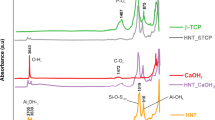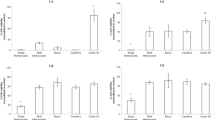Abstract
Objectives
The aim of this study was to evaluate the influence of [2-(methacryloyloxy)ethyl] trimethylammonium chloride (METAC) in the physico-chemical properties, antibacterial activity and cytotoxicity of an experimental resin–based sealant.
Materials and methods
An experimental resin-based sealant was formulated with dimethacrylates and a photoinitiator system. METAC was added at 2.5 wt.% (G2.5%) and 5 wt.% (G5%) into the experimental resin–based sealant, and one group remained without METAC as control (GCTRL). The resin-based sealants were analysed for polymerization behaviour and degree of conversion (DC), Knoop hardness (KHN) and softening in solvent (ΔKHN), ultimate tensile strength (UTS), contact angle, surface free energy (SFE), immediate and long-term micro-shear bond strength (μ-SBS) and antibacterial activity and cytotoxicity against human keratinocytes.
Results
The experimental resin–based sealants presented different polymerization behaviours without significant differences in the DC (p > 0.05). There was no significant difference for initial KHN (p > 0.05). The ΔKHN ranged from 51.62 (±3.70)% to 62.40 (±4.14)%, with higher values for G5% (p < 0.05). G2.5% and G5% had decreased μ-SBS between immediate and long-term tests (p < 0.05) without significant differences among groups in the immediate and long-term analyses (p > 0.05). There were no significant differences for UTS, contact angle and SFE among groups (p > 0.05). G2.5% and G5% presented immediate and long-term antibacterial activity (p < 0.05) without cytotoxicity compared to GCTRL (p > 0.05).
Conclusion
The addition of METAC provided antibacterial activity to the experimental resin–based sealant.
Clinical relevance
METAC is an effective quaternary ammonium compound as an antibacterial agent for resin-based sealants without cytotoxic effects against human keratinocytes.



Similar content being viewed by others
References
Borges BC, Souza Borges J, Braz R et al (2012) Arrest of non-cavitated dentinal occlusal caries by sealing pits and fissures: a 36-month, randomised controlled clinical trial. Int Dent J 62:251–255. https://doi.org/10.1111/j.1875-595X.2012.00117.x
Holmgren C, Gaucher C, Decerle N, Doméjean S (2014) Minimal intervention dentistry II: part 3. Management of non-cavitated (initial) occlusal caries lesions--non-invasive approaches through remineralisation and therapeutic sealants. Br Dent J 216:237–243. https://doi.org/10.1038/sj.bdj.2014.147
Chestnutt IG, Playle R, Hutchings S, Morgan-Trimmer S, Fitzsimmons D, Aawar N, Angel L, Derrick S, Drew C, Hoddell C, Hood K, Humphreys I, Kirby N, Lau TMM, Lisles C, Morgan MZ, Murphy S, Nuttall J, Onishchenko K, Phillips C, Pickles T, Scoble C, Townson J, Withers B, Chadwick BL (2017) Fissure seal or fluoride varnish? A randomized trial of relative effectiveness. J Dent Res 96:754–761. https://doi.org/10.1177/0022034517702094
Ahovuo-Saloranta A, Forss H, Walsh T, Nordblad A, Mäkelä M, Worthington HV, Cochrane Oral Health Group (2017) Pit and fissure sealants for preventing dental decay in permanent teeth. Cochrane Database Syst Rev:7, CD001830. https://doi.org/10.1002/14651858.CD001830.pub5
Ahovuo-Saloranta A, Forss H, Walsh T et al (2013) Sealants for preventing dental decay in the permanent teeth. Cochrane Database Syst Rev 3:CD001830. https://doi.org/10.1002/14651858.CD001830.pub4
Imazato S (2003) Antibacterial properties of resin composites and dentin bonding systems. Dent Mater 19:449–457. https://doi.org/10.1016/S0109-5641(02)00102-1
Cury JA, de Oliveira BH, dos Santos AP, Tenuta LM (2016) Are fluoride releasing dental materials clinically effective on caries control? Dent Mater 32:323–333. https://doi.org/10.1016/j.dental.2015.12.002
Imazato S, Kawakami M, Torii M, Tsuchitani Y (1992) Antibacterial activity of composites containing chemically bound non-releasing antibacterial component. J Dent Res 72:721
Pashley DH, Tay FR, Imazato S (2011) How to increase the durability of resin-dentin bonds. Compend Contin Educ Dent 32:60–64
Donmez N, Belli S, Pashley DH, Tay FR (2005) Ultrastructural correlates of in vivo/in vitro bond degradation in self-etch adhesives. J Dent Res 84:355–359. Erratum in: J Dent Res. 2006 Apr;85(4):384. https://doi.org/10.1177/154405910508400412
Pinto CF, Paes Leme AF, Ambrosano GM, Giannini M (2009) Effect of a fluoride- and bromide-containing adhesive system on enamel around composite restorations under high cariogenic challenge in situ. J Adhes Dent 11(4):293–297
Collares FM, Leitune VCB, Franken P et al (2017) Influence of addition of [2-(methacryloyloxy)ethyl] trimethylammonium chloride to an experimental adhesive. Braz Oral Res 31:e31. https://doi.org/10.1590/1807-3107BOR-2017.vol31.0031
Stopiglia CD, Collares FM, Ogliari FA et al (2012) Antimicrobial activity of [2-(methacryloyloxy)ethyl] trimethylammonium chloride against Candida spp. Rev Iberoam Micol 29:20–23. https://doi.org/10.1016/j.riam.2011.03.003
Hamilton MF, Otte AD, Gregory RL, Pinal R, Ferreira-Zandoná A, Bottino MC (2015) Physicomechanical and antibacterial properties of experimental resin-based dental sealants modified with nylon-6 and chitosan nanofibers. J Biomed Mater Res B Appl Biomater 103:1560–1568. https://doi.org/10.1002/jbm.b.33342
Garcia IM, Souza VC, Hellriegel C, Scholten JD, Collares FM (2019) Ionic liquid-stabilized titania quantum dots applied in adhesive resin. J Dent Res 98:682–688. https://doi.org/10.1177/0022034519835203
Rodrigues SB, Collares FM, Leitune VCB, Schneider LFJ, Ogliari FA, Petzhold CL, Samuel SMW (2015) Influence of hydroxyethyl acrylamide addition to dental adhesive resin. Dent Mater 31:1579–1586. https://doi.org/10.1016/j.dental.2015.10.005
Collares FM, Ogliari FA, Zanchi CH, Petzhold CL, Piva E, Samuel SM (2011) Influence of 2-hydroxyethyl methacrylate concentration on polymer network of adhesive resin. J Adhes Dent 13:125–129. https://doi.org/10.3290/j.jad.a18781
Degrazia FW, Leitune VCB, Garcia IM et al (2016) Effect of silver nanoparticles on the physicochemical and antimicrobial properties of an orthodontic adhesive. J Appl Oral Sci 24:404–410. https://doi.org/10.1590/1678-775720160154
Owens DK, Wendt RC (1969) Estimation of the surface free energy of polymers. J Appl Polym Sci 13:1741–1747
Garcia IM, Leitune VCB, Visioli F, Samuel SMW, Collares FM (2018) Influence of zinc oxide quantum dots in the antibacterial activity and cytotoxicity of an experimental adhesive resin. J Dent 73:57–60. https://doi.org/10.1016/j.jdent.2018.04.003
Schiroky PR, Leitune VCB, Garcia IM, Ogliari FA, Samuel SMW, Collares FM (2017) Triazine compound as copolymerized antibacterial agent in adhesive resins. Braz Dent J 28:196–200. https://doi.org/10.1590/0103-6440201701346
Munchow EA, Zanchi CH, Ogliari FA et al (2014) Replacing HEMA with alternative dimethacrylates in dental adhesive systems: evaluation of polymerization kinetics and physicochemical properties. J Adhes Dent 16:221–228. https://doi.org/10.3290/j.jad.a31811
Andrzejewska E (2001) Photopolymerization kinetics of multifunctional monomers. Prog Polym Sci 26:605–665. https://doi.org/10.1016/S0079-6700(01)00004-1
Flury S, Lussi A, Hickel R, Ilie N (2014) Light curing through glass ceramics: effect of curing mode on micromechanical properties of dual-curing resin cements. Clin Oral Investig 18:809–818. https://doi.org/10.1007/s00784-013-1051-y
Wegehaupt F, Jorge F, Attin T (2017) Influence of shortened light-curing duration on the potential of resin-based surface sealants to prevent erosion. Oral Health Prev Dent 15:79–87. https://doi.org/10.3290/j.ohpd.a37717
Borges BC, Bezerra GV, Mesquita JA et al (2011) Effect of irradiation times on the polymerization depth of contemporary fissure sealants with different opacities. Braz Oral Res 25:135–142. https://doi.org/10.1590/S1806-83242011000200007
Almaroof A, Niazi SA, Rojo L, Mannocci F, Deb S (2016) Influence of a polymerizable eugenol derivative on the antibacterial activity and wettability of a resin composite for intracanal post cementation and core build-up restoration. Dent Mater 32:929–939. https://doi.org/10.1016/j.dental.2016.04.001
Degrazia FW, Leitune VCB, Samuel SMW, Collares FM (2017) Boron nitride nanotubes as novel fillers for improving the properties of dental adhesives. J Dent 62:85–90. https://doi.org/10.1016/j.jdent.2017.05.013
Almaroof A, Niazi SA, Rojo L, Mannocci F, Deb S (2017) Evaluation of dental adhesive systems incorporating an antibacterial monomer eugenyl methacrylate (EgMA) for endodontic restorations. Dent Mater 33:e239–ee54. https://doi.org/10.1016/j.dental.2017.01.016
Drago L, Toscano M, Bottagisio M (2018) Recent evidence on bioactive glass antimicrobial and antibiofilm activity: a mini-review. Materials 11:326. https://doi.org/10.3390/ma11020326
Yeaman MR, Yount NY (2003) Mechanisms of antimicrobial peptide action and resistance. Pharmacol Rev 55:27–55. https://doi.org/10.1124/pr.55.1.2
Makvandi P, Jamaledin R, Jabbari M, Nikfarjam N, Borzacchiello A (2018) Antibacterial quaternary ammonium compounds in dental materials: a systematic review. Dent Mater 34:851–867. https://doi.org/10.1016/j.dental.2018.03.014
Kuhnisch J, Mansmann U, Heinrich-Weltzien R et al (2012) Longevity of materials for pit and fissure sealing--results from a meta-analysis. Dent Mater 28:298–303. https://doi.org/10.1016/j.dental.2011.11.002
Rego GF, Vidal ML, Viana GM, Cabral LM, Schneider LFJ, Portela MB, Cavalcante LM (2017) Antibiofilm properties of model composites containing quaternary ammonium methacrylates after surface texture modification. Dent Mater 33:1149–1156. https://doi.org/10.1016/j.dental.2017.07.010
Tonder A, Joubert AM, Cromarty AD (2015) Limitations of the 3-(4,5-dimethylthiazol-2-yl)-2,5-diphenyl-2H-tetrazolium bromide (MTT) assay when compared to three commonly used cell enumeration assays. BMC Res Notes 8:47. https://doi.org/10.1186/s13104-015-1000-8
International Organization for Standardization (ISO) (2009) ISO 10993-5:2009(E) 1–34
Zingler S, Matthei B, Diercke K, Frese C, Ludwig B, Kohl A, Lux CJ, Erber R (2014) Biological evaluation of enamel sealants in an organotypic model of the human gingiva. Dent Mater 30:1039–1051. https://doi.org/10.1016/j.dental.2014.06.002
Mikulas K, Hermann P, Gera I et al (2018) Triethylene glycol dimethacrylate impairs bioenergetic functions and induces oxidative stress in mitochondria via inhibiting respiratory complex I. Dent Mater 34:e166–e118. https://doi.org/10.1016/j.dental.2018.03.012
Funding
This study was financed in part by the Coordenação de Aperfeiçoamento de Pessoal de Nível Superior—Brasil (CAPES)—Finance Code 001.
Author information
Authors and Affiliations
Corresponding author
Ethics declarations
Conflict of interest
The authors declare that they have no conflict of interest.
Ethical approval
This article does not contain any studies with human participants or animals performed by any of the authors.
Informed consent
For this type of study, formal consent is not required.
Additional information
Publisher’s note
Springer Nature remains neutral with regard to jurisdictional claims in published maps and institutional affiliations.
Rights and permissions
About this article
Cite this article
Garcia, I.M., Rodrigues, S.B., de Souza Balbinot, G. et al. Quaternary ammonium compound as antimicrobial agent in resin-based sealants. Clin Oral Invest 24, 777–784 (2020). https://doi.org/10.1007/s00784-019-02971-4
Received:
Accepted:
Published:
Issue Date:
DOI: https://doi.org/10.1007/s00784-019-02971-4




